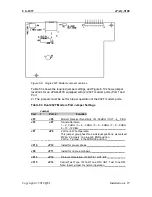
UG-1037
ePAQ-9100
12
Hardware Overview
Copyright © 2017 QEI
3
Hardware Overview
The ePAQ-9100 consists of four major functional sections: the main processor
and memory, the communications section, the local I/O interface and the power
section.
3.1 Main Processor and Memory
The ePAQ-
9100’s Main Processor section is made up of a Motorola 68331 32-bit
microprocessor, a clock generator and watchdog timers. The microprocessor
handles all I/O and communications services.
There are two types of memory in the ePAQ-9100: FLASH and RAM. The
FLASH memory is divided into Program Memory block, which is used for
program storage and e Data Memory block for configuration storage. The RAM
memory is used for program variables and data. A block of non-volatile RAM
memory is available for long-term data storage.
3.2 Communications Interface
The ePAQ-9100 may optionally contain circuitry for up to nine (9) serial
communication ports, up to (2) Bell 202T modem ports, up to (1) IRIG-B interface
port, and up to (2) Ethernet ports (Base T and Base FX). Because the ePAQ-
9100 can be configured in different ways, not all of the ports discussed here may
be available in every ePAQ. The following are descriptions of the ommunications
ports usage in a typical SCADA system including, their physical interfaces and
options available to them. The nine serial ports on the 6CPP6 panel, and their
currently assigned functions are:
1
Port #1
General Purpose
RS-232 or 202T
Bit/Byte Oriented
synchronous
– asynchronous
150 - 38,400 bps
2
Port #2
General Purpose
RS-232 or 202T
Bit/Byte Oriented
synchronous
– asynchronous
150 - 38,400 bps
3
Port #3
Maintenance Panel
RS-232 interface
Byte Oriented
Asynchronous
150 - 57,600 BPS
4
Port #4
General Purpose
RS-232 interface
Byte Oriented
synchronous
– asynchronous
150 - 38,400 bps
5
Port #5
IED Communication Port
RS-485 (2 Wire)
Byte Oriented
synchronous
– asynchronous
150 - 38,400 bps















































